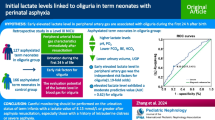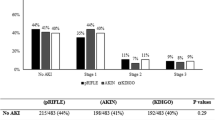Abstract
The purpose of this study was to determine the prevalence and types of acute renal failure in asphyxiated full-term neonates and to evaluate the accuracy of an asphyxia morbidity score in predicting acute renal failure. Neonates admitted to one institution from 1990 through 1993 with a gestational age ≥36 weeks and 5-min Apgar score ≤6, without congenital malformations or sepsis, were studied retrospectively for acute renal failure in the 1st week of life. Acute renal failure was defined as serum creatinine >1.5 mg/dl (133 μmol/l) with normal maternal renal function. Nonoliguric renal failure was defined as renal failure with urine output >1 ml/kg per hour after the 1st day. An asphyxia morbidity scoring system was used to distinguish severe from moderate asphyxia. The score ranged from 0 to 9 and was based upon fetal heart rate, Apgar score at 5 min, and base deficit in the 1st h of life. The score for severe asphyxia was defined as 6–9 and for moderate asphyxia as 1–5. Sixty-six neonates fulfilled study criteria. Acute renal failure was present in 20 of 33 (61%) infants with severe asphyxia scores and 0 of 33 with moderate asphyxia scores (P<0.0001). Acute renal failure was nonoliguric in 12 of 20 (60%), oliguric in 5 of 20 (25%) and anuric in 3 of 20 (15%). In conclusion 1) acute renal failure occurred in 61% of infants with severe asphyxia, 2) acute renal failure associated with severe asphyxia was predominantly nonoliguric and 3) an asphyxia morbidity score, which can be determined at 1 h of age, predicted acute renal failure in full-term infants with 100% sensitivity and 72% specificity.
Similar content being viewed by others
References
Norman ME, Assadi FK (1979) A prospective study of acute renal failure in the newborn infant. Pediatrics 63: 475–480
Stapleton FB; Jones DP; Green RS (1987) Acute renal failure in neonates: incidence, etiology, and outcome. Pediatr Nephrol 1: 314–320
Dauber IM, Kraus AN; Symchych PS, Auld PAM (1976) Renal failure following perinatal anoxia. J Pediatr 88: 851–855
Portman RJ, Carter BS, Gaylord MS, Murphy MG, Thieme RE, Merenstein GB (1990) Predicting neonatal morbidity after perinatal asphyxia: a scoring system. Am J Obstet Gynecol 162: 174–182
Roberts DS, Haycock GB, Dalton RN, Turner C, Tomlinson P, Stimmler L, Scopes JW (1990) Prediction of acute renal failure after birth asphyxia. Arch Dis Child 65: 1021–1028
Chevalier RL, Campbell F, Brenbridge ANAG (1984) Prognostic factors in neonatal acute renal failure. Pediatrics 74: 265–272
Parer JT (1994) Fetal heart rate. In: Creasy RK, Resnik R (eds) Maternal-fetal medicine: principles and practice, 3rd edn. Saunders, Philadelphia, pp 314–317
Schwartz GJ, Feld LG, Langford DJ (1984) A simple estimate of glomerular filtration rate in full-term infants during the first year of life. J Pediatr 104: 849–854
Guignard JP (1982) Renal function in the newborn infant. Pediatr Clin North Am 29: 777–790
Adelman RD, Wirth F, Rubio T (1987) A controlled study of the nephrotoxicity of mezlocillin and gentamicin plus ampicillin in the neonate. J Pediatr 111: 888–893
Fischereder M, Trick W, Nath KA (1994) Therapeutic strategies in the prevention of acute renal failure. Semin Nephrol 14: 41–52
Sutter PM, Thulin G, Stromski M, Ardito T, Gaudio KM, Kashgarian M, Siegel NJ (1988) Beneficial effect of thyroxine in the treatment of ischemic acute renal failure. Pediatr Nephrol 2: 1–7
Gaudio KM, Ardito TA, Reilly H, Kashgarian M, Siegel NJ (1983) Accelerated cellular recovery after an ischemic renal injury. Am J Pathol 112: 338–346
Hammerman MR, Miller SB (1994) Therapeutic use of growth factors in renal failure. J Am Soc Nephrol 5: 1–11
Leonidas JC, Berdon WE, Gribetz D (1971) Bilateral renal cortical necrosis in the newborn infant: roentgenographic diagnosis. J Pediatr 79: 623–627
Anand SK, Northway JD, Crussi FG (1978) Acute renal failure in newborn infants. J Pediatr 92: 985–988
Rasoulpour M, McLean RH (1980) Renal venous thrombosis in neonates. Am J Dis Child 134: 276–279
Author information
Authors and Affiliations
Rights and permissions
About this article
Cite this article
Karlowicz, M.G., Adelman, R.D. Nonoliguric and oliguric acute renal failure in asphyxiated term neonates. Pediatr Nephrol 9, 718–722 (1995). https://doi.org/10.1007/BF00868721
Received:
Revised:
Accepted:
Issue Date:
DOI: https://doi.org/10.1007/BF00868721




